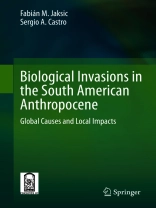This book provides a conceptually organized framework to understand the phenomenon of biological invasions at the Anthropocene global scale. Most advances toward that aim have been provided from North American and European researchers, with fewer contributions from Australia and South Africa. Here we fill the void from the Neotropics, focusing on the research experience in South American countries, with a strong emphasis on Argentina and Chile.
The text is divided into two parts: The first half comprises self-contained chapters, providing a conceptual, bibliographic and empirical foundation in the field of invasion biology, from an Anthropocene perspective. The second half reviews the ecology, biogeography, and local impacts in South America of exotic species groups (European rabbit, Eurasian wild boar, Canadian beaver, North American mink, and Holarctic freshwater fishes), which are shown to be useful models for case studies of global relevance.Tabella dei contenuti
Preface.- Part 1. Conceptual Framework.- Chapter 1. Introduction to the Phenomenon of Biological Invasions.- Chapter 2. Biological Invasions in the Anthropocene.- chapter 3. Transport and Introduction.- Chapter 4. Naturalisation.- Chapter 5. Range Expansion.- Chapter 6. Impacts on Health, Economy and Diversity.- Chapter 7. Ecological Impacts.- Part 2. Case Studies.- Chapter 8. European Rabbit (Oryctolagus cuniculus) in Chile: The Human Dimension Behind a Biological Invasion.- Chapter 9. Invasive European Wild Rabbits (Oryctolagus cuniculus) in Argentina: State of the Art and Prospects for Research.- Chapter 10. Wild Boar Invasion in Argentina and Chile: Ecology, Impacts and Distribution.- Chapter 11. Reconceiving the Biological Invasion of North American Beavers (Castor Canadensis) in Southern Patagonia as a Socio-ecological Problem: implications and opportunities for research and management.- Chapter 12. Invasion by a Carnivore: the case of american mink (neovison vison) in southamerica.- Chapter 13. Homogenization of the Freshwater Fish Fauna in Chile: analysing the ichthyogeographic provinces. References.
Circa l’autore
Fabián M. Jaksic has a degree in Biology from the University of Chile, a Ph D in Zoology from the University of California (Berkeley), is an American Ecological Society’s Certified senior ecologist, and a member of the Chilean Academy of Sciences. He is currently a professor and director of the Center of Applied Ecology and Sustainability of the Pontificia Universidad Católica de Chile (CAPES-UC), and is the author of over 230 Wo S-indexed scientific articles, over 50 book chapters, and of 12 books. Jaksic has also received numerous awards and prizes, including Fullbright and Guggenheim scholarships, Chile’s Presidential Chair in Science, and Chile’s National Prize in Natural Sciences.
Sergio A. Castro holds a B.S. degree in Biological Sciences and a Ph D in Biological Sciences with a major in Ecology from the Pontificia Universidad Católica de Chile. He is currently an associate professor at the School of Chemistry and Biology of the Universidad de Santiago de Chile. Castro has developed research in the field of plant ecology and biogeography, as well as on plant and vertebrate invasions. He is the author of 50 Wo S scientific articles, of 6 book chapters, and co-author of three books. He is also an associate researcher with the Center of Applied Ecology and Sustainability of the Pontificia Universidad Católica de Chile (CAPES-UC).












